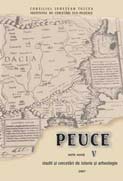Mărci de olar descoperite la Isaccea (Noviodunum) – jud. Tulcea
Potter’s Marks Discovered in Isaccea (Noviodunum) – Tulcea County
Author(s): Cristina Paraschiv-Talmaţchi, Aurel StănicăSubject(s): Archaeology
Published by: Institutul de Cercetari Eco-Muzeale Tulcea - Institutul de Istorie si Arheologie
Keywords: Isaccea - Noviodunum; mărci de olar; secolele X – XI; potter’s marks; 10th–11th centuries
Summary/Abstract: We have deemed it necessary to start with a short description of the archaeological campaigns undertaken in Isaccea / Noviodunum, specifying the sites that they targeted for the creation of a general image, but our intention is to make known a part of the archaeological material that resulted from these campaigns, represented by ceramic vessel fragments that bear potter’s marks. It is a batch of 45 such pieces, composed of nine old discoveries (six from 1953 and three from 1970-1971) and 36 that are more recent (appearing during 1995-2003). To this we have added, for the sake of comparison, a fragment (from 1996) that only displays uneven surfaces. We do not think that the pieces from 1953 have been published. They probably originate from the cliff area. The ones from 1970-1971, which have appeared as a result of carrying out some surveys on the eastern confines, have been published by I. Barnea and Al. Barnea. We have mentioned them for the creation of a complete image regarding this type of materials. The last 36 come from the civil settlement (outside the walls – from the south-eastern edge of the Roman-Byzantine city), from the city (the Turnul Mare area), and from the “Cariera de lut” or “Lutărie” points (outside the walls). From a chronological point of view, the pieces that have been analyzed belong to the 10th – 11th centuries, although, on the basis of some signs rendered as marks, as well as on the basis of the manufacturing method of some of the containers, we do not rule out the possibility that a part of them could have been made later – maybe even during the 12th century AD. The potter’s marks, present on the bottom of the vessels that were discovered in Isaccea-Noviodunum have been made in relief. Many of them have analogies among similar discoveries from Romania; some are alike or have common elements with marks that are present on containers that appeared in sites from other countries. It must be said that, among the pieces that we have presented, there are items for which we have not been able to find analogies (described in the catalogue at the positions 1, 14, 32 and 38).
Journal: Peuce (Serie Nouă) - Studii şi cercetari de istorie şi arheologie
- Issue Year: III/2005
- Issue No: 3-4
- Page Range: 283-304
- Page Count: 22
- Language: Romanian

